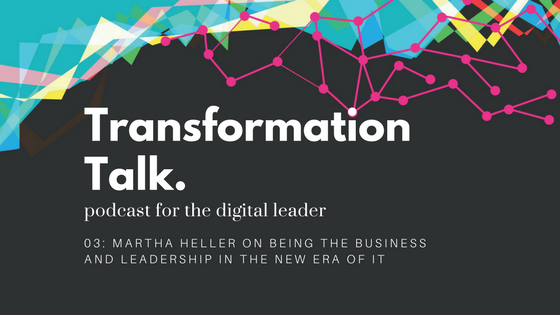She's been a CIO.com contributor since 1999, and was founder of the CIO Executive Council, IDG's professional organization for CIOs.

Martha is CEO of Heller Search Associates, an executive recruiting firm that specializes in IT leadership positions nationwide, across all industries. Through all of these platforms, Martha has built a large, intellectually-engaged network of IT executives, many of whom contribute to her widely-read e-newsletter, "The Heller Report." Target Research recently named Martha as the top influencer of US CIO's in the HR category, and number two overall.
Why does Heller Search Associates specialize in senior-level IT positions?
I joined CIO Magazine in the late '90s, and I've just been fascinated by the evolution of the CIO role and how incredibly important IT is to every facet of a company. When you think about it, IT can make or break a company's business strategy and their success, and yet, CEOs still don't really understand the role of the CIO, and they don't really understand how to position their CIOs for success. And to me, that has always been fascinating.
RELATED: How To Move Your Org Toward a Process Excellence Culture
When companies come to you with a position to fill, are you doing it with digital transformation in mind specifically?
Digital transformation comes up all the time. Customers want to connect differently to the companies that are providing them with products and services. It's changing the fundamentals of the company. It's changing not just how the company does what it does, but what the company does. Digital is changing business models.
CEOs are recognizing that their companies’ business models are changing, but most companies have not been investing in IT in a consistent way. So now CEOs are saying, “Oops. We didn't invest in technology. We've got to leapfrog over all this legacy technology because we need new digital channels that integrate seamlessly with one another. This is a major issue for us. We need a CIO who can help lead us into the future.”
You could tell the same story in retail, manufacturing, internet of things. You could tell the same story with financial services, with blockchain, any company these days with artificial intelligence. The very foundation of what companies do is impacted by technology, and they need a technology leader who is going to be a very forceful executive in their ranks. And so digital transformation is very often the single driver for a company's search for a new CIO.
What do you see is the role of a Chief Digital Officer?
Chief Digital Officer is a new role and it does not enjoy a consistent definition. Chief Digital Officer is different in every company. I believe that the Chief Digital Officer is a transitional role as companies start to make a point to their executors and customers that online, social media, and mobile channels matter now. But I think it's going to go away, and I think you're going to have your traditional executive functions back. CFO, CMO, all of that. CIO. And everybody's just going to be operating with a digital mindset and with digital tools.
My advice to CIOs is that when your CEO starts talking about a Chief Digital Officer, look in the mirror and understand the level of credibility and leadership that you have in your role. Because the digital function should not be a function, it should be a capability that you as CIO bring to your company. A CIO friend of mine said, "How do you know when the CIO and the CMO don't get along? When your CEO hires a Chief Digital Officer."
I look forward to the day when we don't have Chief Digital Officers because it will mean we have adjusted to a digital world.
What happens when technology vendors and the end users who buy their products work directly with each other and don't involve IT?
Let's identify the two poles. One pole is where the CIO controls all technology resources and all technology purchasing. Then the other pole is where the business is buying technology left and right and the CIO has no control. Neither of those poles is the right place to be. And it's up to executive committees to decide what that right space between the poles is for them.
Coming up with that right formula is a huge job for CIOs and their executive peers. Eash Sundaram, the CIO of JetBlue, said to me, "IT is no longer a skillset that belongs solely in IT. IT is a toolkit, and everyone in a company should have access to that toolkit. And it is my job as CIO to make that happen." When you build a platform and a culture where you can crowdsource innovation from anywhere in the company, anyone can be a developer. And so long as the guidelines are in place, that's good for the company.
What are some best practices in digital transformation that you find inspiring?
One is thinking about products and tools (whether they're for internal consumption or customer consumption) and the concept of a minimal viable product. It's where IT develops, working closely with its business partners, just the smallest instance of a product to get immediate feedback. Get that feedback, develop the next instance. Rather than saying, "Okay business, what do you want? Lots of bells and whistles. We're gonna go away, and someday we will return with something." The chances are likely that your needs have changed dramatically since then.
Another best practice for digital innovation or transformation would be to tear down the wall between the business and IT, and create a small, nimble product teams. It's a business capability. We want to convert more prospects to customers. We want to create more leads. Go cross-functional! Team up IT, user experience, marketing, product, and operations. Work together and to come up with a solution on that capability.
ALSO READ: Dialog with Enterprise IT to Encourage Digital Entrepreneurism
So the best practice that I would really focus on, were I a CIO in an organization, is looking around and saying, "Where are the walls that are dividing IT and all of our business functions? How do we tear down those walls and co-create?” So that all of the best minds are on what the employee or the customer needs and we’re all working together on the same problem.
Follow Martha on Twitter @marthaheller and by signing up to receive The Heller Report e-newsletter at www.hellersearch.com.
About the Author
Nicole is Director of Marketing at Kintone, with 10+ years experience in content strategy, campaign management, lead acquisition and building positive work cultures of empowered, purpose-driven team members. She spent seven years as a journalist, previously serving as a CBS San Francisco digital producer, NPR contributor, Patagon Journal deputy editor and reporter for several publications, including the Chicago Tribune. She's passionate about the tech for good space, social entrepreneurship and women leadership. On the weekends, you’ll likely find her putting her Master Gardener skills to use in at community gardens in Oakland.











